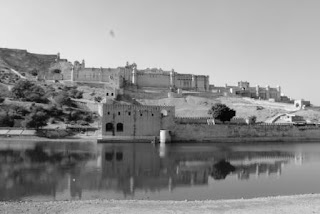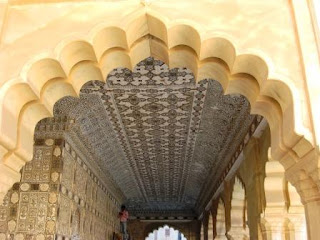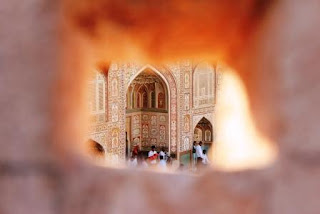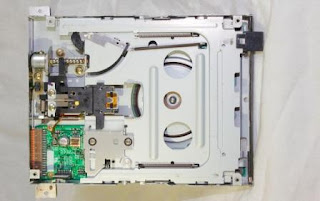It all started with figuring out vacation ideas; considering that we would be travelling in December, colder climes were naturally ruled out. M had been wanting to do Rajasthan for a while, so we decided that the land of golden sands it would be, since anytime after March and the place would be scorching.
Since the tourist season starts mid-December, we decided to plan our trip in the first week, before the hordes start pouring in. The days would be pleasant, the nights chill but not freezing and the crowds, few. We only had about a week on our hands, so the planning had to be meticulous - not crowd the itinerary with too many places to visit, yet not miss out on the must do spots. The credit again goes to M for a perfectly planned holiday - right from what to see, where to stay, what to eat, which taxiwalla to call etc.,!
For starters, Rajasthan is a state that has endless possibilities: forts, deserts, wildlife parks, luxurious palaces, spread across many must visit places such as Jaipur, Udaipur, Jaisalmer, Jodhpur, Bikaner, Ranthambore... Considering my shutter happy nature and the need for a relaxed holiday, we decided on Jaipur, Jaisalmer and Jodhpur. No more.
For details on the planning bit, do's and don'ts, refer to
M's blog. My blog is not meant to be a travel-diary, but a collection of the impressions gathered during that fabulous one week.
As we landed at Jaipur Airport at 7.30 AM, the captain's welcome message shattered some typical 'tourist myths' about Rajasthan, "Ladies and gentlemen, welcome to Jaipur; the temperature outside is a pleasant 17 degrees..." Wow! So Rajasthan, is not really the 'perpetual 50 degrees oven!'
Jaipur is a beautiful city, with broad straight streets, swept clean, shrouded in the morning chill - very welcoming. It's a fairly green city too - disappointing tourists who assume that all of Rajasthan is only sand! This is also the city of beautiful palaces - Jal Mahal and City Palace for instance, forts - Amer and Jaigarh, astronomical observatory - Jantar Mantar, lakes, markets. The people are friendly and affable, willing to guide the lost tourist.
 |
| Hawa Mahal, in the soft golden light of the morning sun |
Our first stop was the Hawa Mahal - most readily recognised icon of the Pink City - so called because the erstwhile Maharani Gayatri Devi ordered the denizens of the inner city to paint their building in pink, so as to lend the place an exclusivity! We reached just in time to catch the golden rays of the early morning sun bathe this exquisite structure in an ethereal glow. Shopkeepers across the street were very willing to let us take shots from their terraces for an access charge of '10 rupee per head only'. "We charge phoren tourists 100 rupee saab..." the chowkidaar of one of these vantage viewpoints confided. He was also more than happy to click our pictures.
 |
| One of the many exquisite jharokas... |
Quick tip for photographers: reach the place before 9.00 AM and use a wide-angle for excellent shots of Hawa Mahal - the early morning rays provide excellent frontal lighting. Get on the terrace of any of the shops for eye-level shots. Telephoto zooms are pretty much useless unless you want to take shots of parts of the structure.
 |
Is this the kind of view the veiled queens and princesses
would have had, of the street below? |
We were blessed with a bright sun, no clouds and a clear day: really, excellent conditions for photography. It was interesting to see busloads of foreign tourists - mostly European and Orient, go gaga over the place - surely, a structure so grand constructed just to let the purdah-bound queens and princesses watch royal processions in relative seclusion must be a rarity.
After spending more than an hour gawking at the place, we finally proceeded to breakfast, at the interestingly named Balaji Restaurant, for a snack of hot parathas, dahi and pickle.
The entire city seemed attuned to tourists - the grandfatherly shopkeeper who starts twirling his generous moustache as soon as two Koreans with cameras slung around their necks approach; the otherwise bored snake charmer who plays his 'been' and wakes up an equally bored cobra to life the moment an excited European couple approach, cameras on the ready; traditionally decked up women who are willing to pose for photographs with you for a payment of '50 rupee only'... The welcome change ofcourse is that none of these tourist friendly people pester you with their wares...
 |
| Intricately designed Peacock Gate |
 |
The diwan-i-khas, straight out of a
period movie |
The next stop was the nearby City Palace, the current residence of the erstwhile rulers, descendants of the Sun and heirs of the Kachawaha dynasty. Part of the palace has been converted into a museum, with standard exhibits of royal furniture, apparel, weapons and utensils. Of particular interest was the Peacock Gate, the northeast entrance to the inner courtyard. Delicately adorned with peacock motifs, the entrance arch is a sight to behold. The other three gates to the courtyard are stunning too, decorated with motifs of waves, lotus and roses. The Palace also has on exhibit huge silver urns, 5.2 ft tall, 340 kgs heavy and with a capacity of 4000 litres, meant to carry Gangajal for the king, on his journeys!
 |
| Samrat Yantra - largest sundial in existence |
Next came the Jantar Mantar, the place that we had been most looking forward to! Constructed by Maharaja Jai Singh II, this is one of the five observatories that he built, and the best preserved. We were lucky to get an excellent guide, and spent over an hour understanding the working and purpose of the various instruments here. The precision with which these instruments have been calibrated is amazing. The
Samrat Yantra, the largest sun dial in the world, gives the local time to a precision of 2 seconds! The experience of being able to actually see the shadow move across the marked marble counter is exhilarating!
 |
Close up of the dial - the shadow on the white marble
is calibrated to a precision of 2 seconds! |
Our guide explained in great detail how each of these yantra's (instruments) worked. He was equally thrilled to find tourists that are inquisitive and interested in finding out more about the place. To his utter surprise, we refused to click any snaps while he was explaining, reserving that for later. What was surprising though was that as we neared an hour and half of 'guide time', he was keen to leave us and look for fresh catch. Apparently, most guides in Rajasthan limit time with each tourist batch to not more than 1.5 hours, something we would encounter at the Amer Fort as well!
Our next stop was the Amer Fort, the location from which Jodha Akbar was shot. En-route, we made a quick stop at the Jal Mahal, now restored to its past glory but sadly, out of bound for tourists. Managed to get a few shots of birds gliding over the surface of the lake, fishing for... what else.... fish!
 |
| Majestic Amer Fort, reflected in the moat below... |
The Amer Fort is a magnificent structure, but before that, we made a stop at the Jaigarh Fort, the Amer Fort's twin and constructed to accomodate the growing needs of the main fort. The primary attraction at Jaigarh was the
Jaivan, the largest cannon ever made. With a barrel 20 ft long and a bore 11 inches large, the cannon has a range of over 40 kms (the Bofors howitzer, by comparison has a 6 inch bore and 35 km range). The cannon however, has not seen any action, having been fired only once, a test shot at that. In that sense, I prefer the
Mendha tope of Daulatabad Fort, the second largest cannon and the
Kalal Bangdi of Murud Janjira. These cannons are battle scarred, intimidating and have character. They look you in the eye with a 'dare mess with me?' attitude. The cannon of Jaigarh was a disappointment.
Lunch was at yet another franchise of the ubiquitous Balaji! It appears that instead of water, Rajasthani's use ghee and butter to cook their food in. Our waiter was severely disappointed that we did not consume more than 2 servings of the mildly sweet choorma, that goes with dal-baati-choorma, or multiple servings of the heavy gatte ki sabji. "Saab, aapne to kuch bhi nahi khaya..." he complained after we had consumed what we thought were elephantine quantities of the 10 course (or was it 14?) meal. This is a Rajasthan standard - these nice people are disappointed if you don't eat the equivalent of 4 people!
 |
| Restoration work in progress at the Sheesh Mahal |
The last stop was the majestic Amer Fort, standing sentinel, aloft on the vast desert plains. Several popular Bollywood movies, the recent one being Jodha Akbar, were shot here. Contrasted to our experience at the Jantar Mantar, the guide at Amer was a disappointment, pitching more about gems, astrology and the like that would no doubt draw the attention of the foreign tourist, but not fort-o-holics like us. The Amer Fort has mostly seen peaceful times, as the rulers, the
Kachwahas, were on friendly terms with the Mughals and then with the British. The striking part of the fort though, is the
Sheesh Mahal, the palace of mirrors, embellished with mirrors imported from Belgium, that still retain their sheen.
Tiny mirrors of all shapes and sizes, set in artistic patterns adorn the walls and ceiling, throwing off slivers of light in all directions. One can only imagine the magic the place would have created, reflecting in thousands, the flame of a single lighted lamp... This surely must have been the inspiration for the
pyaar kiya to darna kya song in the epic
Mughal-e-azam. The ceiling and walls are covered in delicate marble carvings that are translucent to the touch, with elaborate paintings of creepers and flowers, and with tiny mirrors set in delicate patterns. The courtyard has a beautiful garden, set in octagonal patterns interspersed with fountains. Cool water was circulated through the walls and lattices, giving a respite from the desert heat. One can only imagine the splendour of this place at the peak of its glory!
 |
| View of Ganesh Pol from the fourth courtyard... |
The terrace of the fort has a huge courtyard, to one end of which the
Ganesh Pol, leads to the
Sheesh Mahal. The entrance arch here is dedicated to Lord Ganesha, and is therefore adorned with motifs attributed to the Lord. The courtyard itself is immense and we were lucky to be there at the close of tourist hours, when the place was near deserted and the place afforded terrific photographic opportunities. Minarets and domes, arches and pillars, set against the backdrop of a clear blue sky, and a photographer had to get shutter happy!
Glimpses of Amer Fort...
 |
| Majesty of the Amer Fort by night... |
It was now time to head to the sound and light show at the ramparts - an hour and half filled with retelling of fort lore. Very well put together and excellently presented, the show is a must see for those interested.
Photographic tip: Make sure to visit the Amer Fort towards the end of the day, so that you get time at the
Sheesh Mahal and
Ganesh Pol courtyard devoid of tourists. Also carry a tripod - the approach road to the fort with the moat and lake below have excellent photographic opportunities to capture the fort reflected in the water below.
 |
| Dining at the very exclusive 1135 AD |
Apparently, the standard time to tour the fort is 45 minutes, with some curious tourists stretching it to over an hour. When we met our driver after spending over 4 hours at the fort (not counting the sound and light show), he exclaimed that this has been his most boring outing to the fort! Imagine his surprise then, when we declared that we wanted to go back into the fort! Not for sightseeing, but to the restaurant 1135 AD. The restaurant is inside the fort, at the second courtyard level, passing right in front of the Sila Devi temple. Strongly recommended for the ambience, excellent food and exceptional service; it was an experience, sitting atop the fort at dusk, with only the sound of the wind blowing over the ramparts for company, enjoying a leisurely dinner. We certainly felt like royals! The credit for finding this gem of a place and arranging for us to have a private dinner goes to M!
After an eventful day, it was finally time to pack the cameras and bid goodbye to Jaipur, as we headed to the Golden City of Jaisalmer! That's for another blog! Watch this space...






























